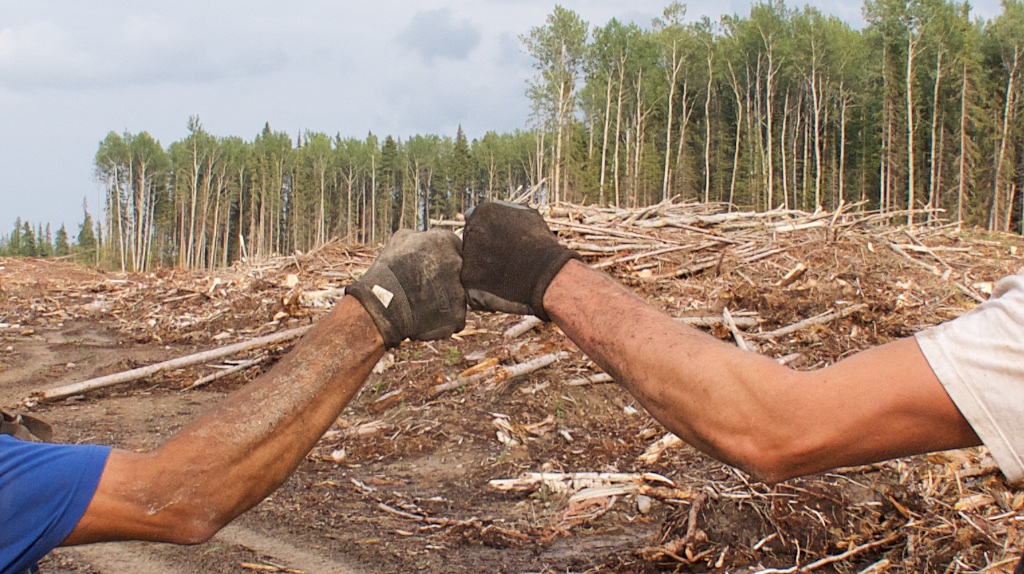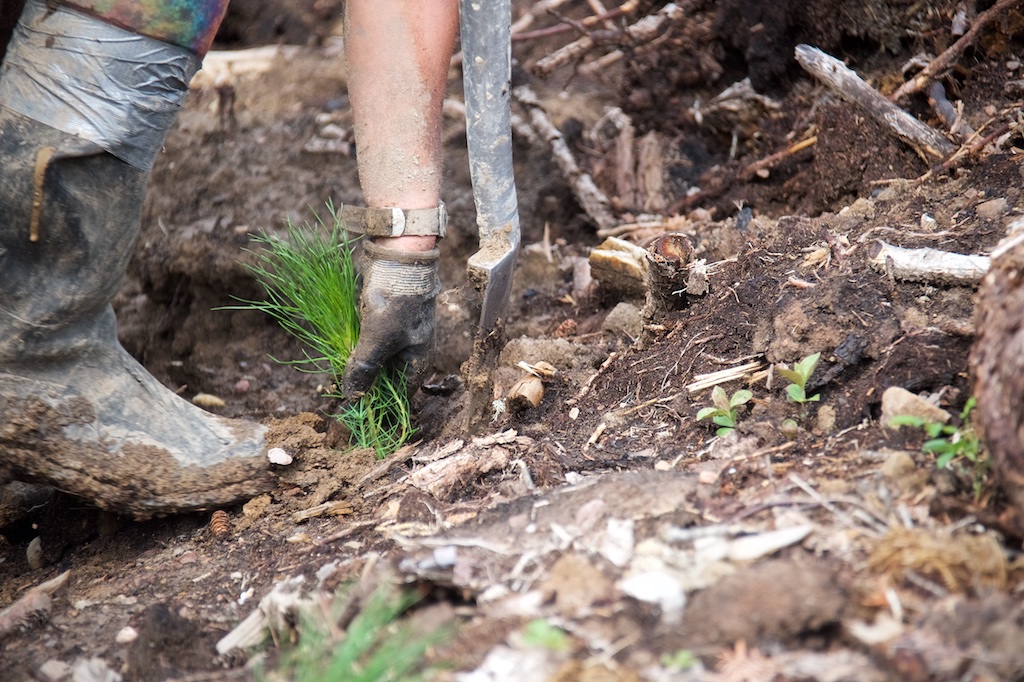Climate Change Action Inspired by Tree Planters
The main Tree Planting story is here.
This page is still under construction, but here’s a start…
Since my day on the cut block, I’ve had ideas buzzing around in my head like honey bees. I have to write them down so they can land and I can sleep at night.

The climate crisis is like mud you can’t wash off the backpack of your mind. (It is a source of anxiety and depression for many people.) On a positive note, the stress of eco-awareness compels me to do research, to seek solutions, signs of progress, and actions that are within my sphere of influence.
As we look at the big picture and struggle to figure out how to best manage the transition to renewables, as a country and as a global community, there is much that is out of our control as individuals.
However, as I mentioned in the tree planters’ story “May the Forest Be With You” we can take on this meaningful, effective challenge:

Footprints in the Peace River hills – deer, canine creatures, and a strange species with no fur, claws or hooves
1. Calculate our CO2 equivalent footprint on an annual basis (See “Sharon calculates her carbon footprint” below).
2. Plant at least enough trees or purchase enough carbon offsets* to suck up the equivalent of the airplane exhaust or the cow burps or whatever greenhouse gas emissions we are responsible for.
*Carbon offset companies fund a variety of verified projects like forest planting, conversion to renewable energy sources, or other emissions reductions projects such as greenhouse gas collection and sequestration.
For example, you can see some LESS projects here. Two of their Canadian projects capture methane from decomposing garbage in landfills. In Eastern Uganda, they provide rural communities with safe sources of drinking water, replacing the need to boil water with wood-burned fire, thereby reducing greenhouse gas emissions, preventing deforestation and improving indoor air quality.
(For more information see “Sharon’s unorthodox butter-flavoured take on carbon offsets” below.)
3. Make a game of trying to shrink our footprint for the coming year and celebrate our new PB (Personal Best) when we succeed.

Some ideas on how this might work:
Community colleges could set up carbon footprint training courses on calculating and reducing carbon footprints for individuals and companies. This could include a community blog post or Facebook page where people can post and discuss their ideas on reducing consumption.
Sharon Calculates her Carbon Footprint
I used this calculator recommended by CBC. It took some doing for a right-brainer like me… I had to add up a year’s worth of kilowatt-hours and gigajoules from our Direct Energy bills and multiply the gigajoules by 277.8 to get kilowatt-hours. Then, due to lack of date-accurate data, I divided the total kilometrage on my 2012 vehicle by seven years. I did some honest-as-I-could-be guesstimating on food consumption, clothing purchases, etc., and I did it!
I calculated my footprint to be 18.33 metric tonnes of CO2equivalent for one year, which is actually pretty bad. I only wear a size 7.5 shoe, but in CO2 terms I have bigger rubber boots than most Canadians (15.12). 7.52 tonnes of it is all the driving around I do in my Chevy Travers.

Sharon’s over-sized carbon footprint
I wonder how many trees I need to plant to absorb that. And what can I do in the coming year to shrink my ecological shoe size?
I tried another calculator which gave me a size 15.44 tonnes. That one didn’t include the secondary footprint calculator that accounts for your purchases. I guess a person could just keep trying different calculators until you come up with a total you like – kind of like trying different weigh scales hoping you’ll lose weight…
or one can just face the footprint and suck it up and mindfully search out ways to improve.
“I will not should on myself!”
Guilt is not a good motivator. That’s why it’s seriously important to make this into a challenging, innovative game that we play in a group.
Tree Planting Footprint Redemption
TPFR could become an annual tradition amongst friends, families and communities. Maybe we could plant trees on Earth Day instead of chopping them down for Christmas. Or if we do chop one down, we could plant two to make up for it.
The possibilities are as numerous as Dalton’s daily planted sapling count!
1. Municipalities could identify and designate areas suitable for creating a community forest or coordinate with farmers who could benefit from the planting of a shelterbelt in their yard or fields.
Trained tree planters could coordinate planting projects that would give people the joy of putting saplings in the ground, securing the soil with their bootprint while compensating for their carbon footprint and making peace with the earth. It would be more fun and psychologically motivating than a carbon tax, and caring for a growing community forest could provide healthy educational outdoor family and community activities.
2. Brad and Rebecca Rabiey operate WEARTH. (You might know them as Carbon Farmer from CBC Dragons’ Den fame). They have a tree-planting project near Manning, AB that is nearing validation for carbon credits. After we’ve calculated our carbon footprint with tools like the one above, we could buy the appropriate amount of CO2eq offsets from this local source.

Brad Rabiey plants a tree – WEARTH.farm – Manning, Alberta
WEARTH can even accommodate groups who want to come out and tour their carbon-storing trees. We could organize a TPFR event for the Peace Region for 2020!
At $15 per tonne, I’ll be paying $275 to remove my 18.33-tonne footprint. I’ll liken it to pulling my boot out of the mud. Maybe I’ll make it an even 20 tonnes just to be safe, so that’ll be $300.
Even if you don’t want to do the math to purchase official carbon credits or offsets, you can still get them to plant trees for you, or for each member of your family, or each employee in your company, to increase wildlife habitat. You can create your forest online that represents the real forest they plant for you in the ground.
3. Here’s another Canadian option: TreeCanada. Taviana has planted trees for TreeCanada. You can read her story here.

Taviana plants a tree in the Chinchaga wilderness
4. Through Conservation International, you can protect an acre of forest in the Amazon for $25 USD (about $35 CDN). Look for the red “protect an acre” button on their home page. “Pessimists never get anything done,” said Conservation International CEO M. Sanjayan in a wide-ranging interview on C-SPAN. It’s natural to be disheartened by the headlines, he told viewers: “We are all part of the problem, but we can also be part of the solution.”
5. OneTreePlanted is another international organization you might want to check out.
6. Still flying to Costa Rica for that yoga retreat, or making a business trip? You can calculate how many tonnes of CO2e will be emitted and purchase Carbon Offset Credits through West Jet or Air Canada when you purchase your ticket. Or you can purchase directly from a verified carbon offset company.
Sharon offsets her flight to Montreal

Goddess of Liberty on the Monument to Sir George-Étienne Cartier in Montreal. The inscription: “We are of different races not for strife but to work together for the common welfare.” Cartier 1865
To offset the emissions from my flight from Edmonton to Montreal to visit my daughter and son-in-law, it cost $19.09 to purchase Gold Standard-Certified International Offsets through a Canadian company called Less. I got a lovely email in response saying,
“Congratulations! You’re now lessening your environmental footprint, supporting innovative emissions reductions projects and making the responsible travel decision.”
Hope!
During this period of transition from fossil fuels to renewables, if we can:
- keep our cool (i.e., better manage our refrigerants) Article here
- take responsibility for our own CO2eq footprints by reducing consumption wherever possible
- preserve and restore forests and/or purchase carbon offset credits to compensate for our emissions
- implement innovative agricultural practices (see below)
- use a good chunk of fossil fuel revenues to further fund development of renewables and needed infrastructure;
we may have a hope in hell of healing this hallowed earth so humans can continue inhabiting it.
Pieces of Light
Millions of Trees
It’s encouraging to know there are millions of trees being planted around the world.
Boreal Research and Peatlands
Research is important to ensure we are planting the best types of trees in the right places and not trying to replace vital peatlands with forest, for example. Peatlands are a type of wetlands that are critical for preserving global biodiversity, providing safe drinking water, minimizing flood risk and helping address climate change. Peatlands store more carbon than all other vegetation types in the world combined, and peatland restoration can bring significant emissions reductions.
The NAIT Boreal Research Institute in Peace River, Alberta is one of over 650 research facilities featured in the Canadian Foundation for Innovation. They collaborate with industry and government and have recruited international experts in forest reclamation, peatland restoration, boreal plant and seed, and forest education.
The Boreal Research Institute conducts trials and develops practical methods and technologies for the collection, treatment and delivery of native boreal seeds and plants for forest and peatland reclamation, helping oil and gas companies and others meet ecological standards for the reclamation of well sites, resource roads, pipeline corridors, etc. They are instrumental in the development of scientifically-based best practices.
You can see one of their videos here.
Students from NAIT’s Forest Technology program have the opportunity to participate in reclamation activities in Peace River and many go on to enjoy rewarding careers in the emerging field of forest reclamation.
I recently attended a NAIT Boreal Research community event presenting recent research on the symbiotic relationship of Aspens and two different types of mycorrhizal fungi and how varying factors affect carbon storage in the soil. Fascinating stuff!
Farmers
I recently read “Women Who Dig” by Peace River author and fire tower lookout, Trina Moyles. This brilliantly-written book of stories from around the world raised within me a heart-wrenching awareness of the impact of global warming on the lives of people with names and faces. It was a disturbing read in many ways.
On the other hand, the courage and tenacity of these women farmers and their innovations inspired me to take a deep breath. Their desire to learn and their ability to come together in their communities, push for changes where they could, and work with professionals to adapt and improve practices inspired hope like a half-obscured candle in a big dark room.
Better land management and agricultural practices (minimizing tillage, leaving crop residue in the ground, planting cover crops, crop rotation, rotational grazing, etc.) can greatly enhance the ability of soils to store carbon and help combat global warming.
A 2017 study estimated that with better management, global croplands have the potential to store an additional 1.85 gigatons carbon each year (1,000,000,000 tonnes)—as much as the global transportation sector emits annually. Moreover, some scientists believe soils could continue to sequester carbon for 20 to 40 years before they become saturated.
“To forget how to dig the earth and to tend the soil is to forget ourselves.” – Mohandas K. Gandhi
Food Waste and Garbage
Landfill sites are a major source of methane, and methane is 25 to 30 times more harmful to the environment than CO2 in terms of global warming. Talk about making the best of a bad situation! Look at this project in Nova Scotia! Since September 2017, the Southeast Eco360 landfill methane capture project has produced enough energy to power 700 homes for a year, while reducing emissions by 66,000 tonnes.
Developing Technology
Still working on this section…
Fossil Fuel Companies
PetroCanada is installing fast-charging stations for electric vehicles across Canada. You can access a map of planned and available stations here.
Shell, BP and Chevron are investing in renewables. “Shell plans to boost spending on its nascent power division to $2 to $3 billion per year by 2025, nearly 10% of its overall spending…The move into power is critical for Shell to meet its ambition to halve its carbon emissions by 2050.” Their newly named UK-based energy supplier, Shell Energy, will also be offering a range of smart home technology…intended to reduce the costs of charging electric vehicles from home. Shell has been criticised for not doing more; however, the same criticism could be aimed at me as a consumer, so I’ve chosen to see this investment in renewables as a piece of light to be celebrated.
Consumers
Consumers are becoming increasingly aware of the fact that, collectively, we have the power to help mitigate climate change by the choices and changes we make to our lifestyle during this critical transition to renewables. The burning of fossil fuels, particularly for the power and transportation sectors, accounts for about three-quarters of our carbon emissions. Much of the convenience and fun we have enjoyed because of fossil fuels is not essential to our survival. Giving up these luxuries would be like giving up an addiction, but it is within our sphere of influence.
Just for fun, I wrote down some radical and some not so radical changes we could make if we’re up to taking the Consumer Climate Action Austerity Challenge.
Government
Canada is going to plant two billion trees over the next ten years…if we can recruit enough tree planters!
Refrigerants
In the 1990s, chlorofluorocarbons (CFCs), which depleted the ozone layer, were replaced with hydrofluorocarbons (HFCs), which are less harmful to the ozone layer, but are contributing significantly to global warming. HFCs are found in air conditioners, refrigerators, and in aerosols.
“The capacity of hydrofluorocarbons (HFCs) to warm the atmosphere is 1,000 to 9,000 times greater than that of carbon dioxide, depending on their exact chemical composition.” Each year, HFC sources emit the carbon-dioxide equivalent released by 300 coal-fired power plants. If left unchecked, HFCs could account for 10 per cent of global greenhouse gas emissions.
In 2017, Penguin Books published the book Drawdown: The Most Comprehensive Plan Ever Proposed to Reverse Global Warming edited by Paul Hawken. Of the Top 10 Solutions to Reverse Climate Change, the first is Refrigerant Management. (Click on this link for more information greenamerica.org)
“Solutions in progress: In October 2016, officials from more than 170 countries gathered in Kigali, Rwanda, to negotiate a deal to address the problem of HFCs. Despite challenging global politics, they reached a remarkable agreement. Through an amendment to the Montreal Protocol, the world will begin phasing HFCs out of use, starting with high-income countries in 2019 and then expanding to low-income countries—some in 2024, others in 2028. HFC substitutes are already on the market, including natural refrigerants such as propane and ammonia. Unlike the Paris Climate Agreement, the Kigali deal is mandatory, with specific targets and timetables.
“Refrigerants currently cause emissions throughout their life cycles, but 90 per cent of emissions happen at disposal. After being carefully removed and stored, refrigerants can be purified for reuse or transformed into other chemicals that do not cause warming.”
Reduction from these actions could be “89.74 gigatons (GT) of reduced CO2-equivalent (CO2-e—the common measure for all greenhouse gases) by 2050.”
Note to Consumers: Check the products you’re using! The Kigali Amendment went into effect on January 1, 2019, and the United States is not participating.
Unfortunately, HFC 152A is in many products familiar to every shopper, including Turtle Wax, WD-40, Air Wick fresheners, Dial, Soft & Dri, Right Guard, Old Spice, Axe, Degree, TRESemme, Dove, and many others. In one case, the CLR Power Plumber Pressurized Drain Opener, the product is 100 per cent HFC. When you blast your plugged toilet, the product releases 4.5 ounces of super greenhouse gas into the atmosphere — the equivalent of up to a ton of CO2 because of HFC’s greater environmental impact.
https://www.bbc.com/future/article/20181102-what-can-i-do-about-climate-change
Piece of Light: Cities
Here’s my unorthodox, butter-flavoured take on carbon offsets:
Cynics have compared purchasing carbon offsets to the misguided practice of purchasing indulgences to pay for your sins
in the middle ages.
If our attitude is “forgive me for the butter I ate during Lent yesterday and, while I’m here, forgive me for the butter I’m going to eat tomorrow and the next day and every day during Lent” then, indeed, we will make no progress, morally or globally.
Just to clarify –
eating butter, clarified or not, is not actually a sin;
it’s just a rule some people in olive-oil-rich Rome made up to make people’s lives in butter-rich Germany so miserable they would be willing to pay for the butter exemption, and that’s why they could afford to build such fancy cathedrals in Europe. It also prompted Luther to nail a pound of protests to the Wittenburg door in 1517. The Protestant Reformation was fuelled, not by coal, but by butter! (I may not have all of these facts exactly right. You can check it out here.)https://history.howstuffworks.com/historical-events/butter-fueled-protestant-reformation.htm
For further clarification, carbon offsets alone do not reduce our emissions. Emissions we are responsible for in one area of the world are compensated for (reduced or sequestered) in another area to bring our net amount of Green House Gases emitted to zero.
It’s kind of like eating a slice of butter kuchen and then riding a recumbent bike fast and furiously enough to burn off all of the calories.
This buttery analogy breaks down in the spreading of the butter exemption money. Instead of building what was referred to as a “butter tower” on a cathedral in the middle ages, carbon credits in the 21st century help fund projects that go to battle against the threat rising from greenhouse gas emissions. Therefore, although carbon credits are not a complete solution to global warming, they are an effective part of the solution.
Of course, the carbon tax is rather like the butter exemption, so if you’re already paying that, you might want to subtract the taxed tonnes related to your vehicle usage, etc. from the total tonnes of your annual carbon footprint before purchasing your offsets. On the other hand, if you’re financially able, you may want to just pay for the same “sin” twice and bless the world with more trees. 😉
